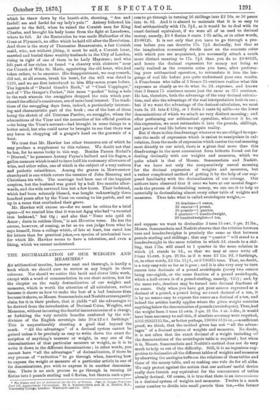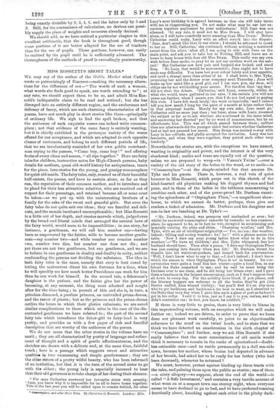THE DECIMALIZATION OF OUR WEIGHTS AND MEASURES.* Ax arithmetical treatise,
however neat and thorough, is hardly a book which we should care to review at any length in these columns. Nor should we notice this lucid and clever little work, except with a word of commendation in our short notices, but for the chapter on the ready decimalization of our weights and measures, which is worth the attention of all calculators, rather because it shows us how to make the best of a bad business than because it shows, as Messrs. Sonnenschein and Nesbitt extravagantly claim for it in their preface, that it yields " all the advantages to be derived from the introduction of Decimal Coins, Weights, and Measures, without incurring the fearful inconveniences of a change, or forfeiting the very notable benefits conferred by the sub- division of the English sovereign into 20 x 12 x 4 farthings." This is unquestionably shooting a good deal beyond the mark. "All the advantages" of a decimal system cannot be gained unless it be precisely as easy to write down the exact de- scription of anything's measure or weight, in any one of the denominations of that particular measure or weight, as it is to write it down in the different denominations ; in other words, you cannot have "all the advantages" of decimalization, if there be any process of " reduction " to go through when, knowing how to express the weight or measure of a particular article in one of its denominations, you wish to express it in another denomina- tion. There is no such process to go through in turning 56 florins into 5 pounds sterling and 6 florins, but there is such a pro-
• The Science and Art of Arithmetic for the Use of Schools. Part II. Vulgar Fractions. Part III. Apprarimate Calculation. By A. Sonnensebeln and H. A. Neabitt, University College, London : Whittaker and Co. 1870.
cess to go through in turning 56 shillings into £2 16s. or 56 pence into 4s. 8d. And it is absurd to maintain that it is as easy to deal arithmetically with 17s. 71d., as it would be to deal with its exact decimal equivalent, if we were all of us used to decimal money, namely, £0 8 florins 8 cents. 1.25 mills, or in other words, £0.88125. It is not only that you have to go through a pro- cess before you can describe 17s. 71d. decimally, but that as the imagination necessarily dwells most on the concrete coins with which you are acquainted, you necessarily attach a much more distinct meaning to 17s. 71d. than you do to 10.88125, and hence the decimal expression for money not being so easily realized as the concrete coins you have, after preform- ing your arithmetical operation, to retranslate it into the lan- guage of real life before you quite understand your own results. A Frenchman who talks of 3 francs 75 centimes realizes what this expresses as clearly as we do what 3s. 2d. expresses, and knows that 3 francs 75 centimes means just the same as 375 centimes. He has, therefore, both the advantage of the easy decimal calcula- tion, and also the advantage of the real interpretation both in one ; but if we want the advantage of the decimal calculation, we must turn 3s. 2d. into £.1581, or 1 florin 5 cents 81 mills—to the lower
denominations of which we attach no very distinct meaning; and after performing our arithmetical operation, whatever it be, on this expression, we must retranslate it into the pounds, shillings, and pence of real life before we regain reality.
But if there is this disadvantage wherever we are obliged to sepa- rate the mode of expression which is easiest to manipulate in cal- culation, from the mode of expression which carries the real meaning most directly to our mind, there is a great deal more than this disadvantage in the most convenient form hitherto found out for dealing decimally with our weights and measures, which we quite admit is that of Messrs. Sonnenschein and Nesbitt. For we have not only the comparatively unreal meaning for the decimal expression of weights and measures, but a rather complicated method of getting it by the help of our sup- posed familiarity with the decimalization of our coinage. Our authors have observed that if once we have at our mental finger- ends the process of decimalizing money, we can use it to help us materially in decimalizing almost every other table of weights and measures. Thus take what is called avoirdupois weight,- 16 drachms-=1 ounce, 16 ounces-=1 pound, 28 pounds=1 quarter,
4 quarters=-1 hundredweight,
20 hundredweights=1 ton,
and suppose we want to decimalize 3 tons 15 cwt. 3 qrs. 211bs., Messrs. Sonnenschein and Nesbitt observe that the relation between tons and hundredweights is precisely the same as that between pounds sterling and shillings ; that any " quarter " will stand to a hundredweight in the same relation in which 3d. stands to a shil- ling, that 7 lbs. will stand to 1 quarter in the same relation in
which id. stands to 3d., so that we may at once write off 3 tons 15 cwt. 3 qrs. 211bs. as if it were £3 15s. 9d. 9 farthings, or, in other words, £3 15s. 1111, or 3.796875 tons. That, no doubt, is a very easy rule so far as it goes ; and it is also very easy to turn ounces into decimals of a pound avoirdupois (every two ounces being one-eighth, or the same fraction of a pound avoirdupois, which a half-crown is of a pound sterling, namely, •125) ; and, by the same rule, drachms may be turned into decimal fractions of an ounce. Only when you have got your ounces expressed as a decimal of a pound, a pound being no exact decimal of a ton, it is by no means easy to express the ounce as a decimal of a ton, and indeed the artifice hardly applies where the given weight contains anything below the denomination of pounds (avoirdupois). Thus, had the weight been 3 tons 15 cwte. 3 qrs. 21 lbs. 4 oz. 5 dra., it would have been necessary to call this, if absolute accuracy were required,
8505.26953125 lbs., or better perhaps, 136084.3125 oz.,—a sufficient proof, we think, that the method given has not " all the advan- tages" of a decimal system of weights and measures. No doubt, it is not often that the exact decimal of a weight including all
the denominations of the avoirdupois table is required ; but when it is, Messrs. Sonnenschein and Nesbitt's method does not do very much to help us out of the difficulty. Still, it is an ingenious sug- gestion to decimalize all the different tables of weights and measures by observing the analogies between the relations of those tables and
those of the money table, and so making one rule do for all alike. We only protest against the notion that our authors' useful device really does furnish any equivalent for the convenience of tables already decimal. Of course, it is true that there is an inconvenience in a decimal system of weights and measures. Twelve is a much easier number to divide into small parcels than ten,—the former
being exactly divisible by 2, 3, 4, 6, and the latter only by 5 and 2. Still, for the convenience of calculation, no devices can possi- bly supply the place of weights and measures already decimal. We should add, as we have noticed a particular chapter in this excellent arithmetic, that the book is throughout good, though some portions of it are better adapted for the use of teachers than for the use of pupils. These portions, however, can easily be omitted by the pupil until he is sufficiently advanced. The thoroughness of the methods of proof is exceedingly praiseworthy.



































 Previous page
Previous page